As carbon emissions rise, replacing fossil fuels with clean energy isn’t the only solution to bring them back down. Increasingly, startups are building tech that sucks CO2 directly from the atmosphere, or even nabs it before it is emitted.
Globally, around 45m tonnes of CO2 are captured from power and industry facilities each year — but that’s nowhere near enough. The International Energy Agency (IEA) estimates we'll need to have removed around 5 gigatonnes — that's 5bn tonnes — of CO2 by 2050 to be on track to limit global warming to 1.5C.
To ramp up carbon removal efforts, governments and investors are getting involved and funnelling cash into the sector. The US Department for Energy has launched a $3.5bn direct air capture hubs programme to support the development of new removal plants — which is catching the attention of European startups — and the UK has set aside £54m of investment into British projects to remove carbon emissions.
Read more: Inside Carbo Culture's biochar plant, one of Europe’s largest carbon removal facilities
There are a few methods of carbon removal. In Europe companies are working on everything from direct air capture and carbon mineralisation to an ancient process used by indigenous groups in the Amazon. Here’s how the different forms of removal work.
Direct air capture
Direct air capture (DAC) does exactly what it says on the tin: removes carbon dioxide directly from the air.
Methods vary, but Swiss startup Climeworks, for example, uses a large fan to draw ambient air through a vent into a collector, where the CO2 sticks to a filter. Once the collector is full, it automatically closes and is heated to 100 degrees. The CO2 is then pumped out, mixed with water and funnelled underground to be pumped into rocks, inside which it mineralises (another method we get into below). A functioning plant will have multiple fans in operation at once.
The resulting product can also be used to make things like sustainable aviation fuels or building materials.
Climeworks has a functioning plant in Iceland, known as Orca. It can remove 4,000 tonnes of CO2 annually, and has raised $810m from investors so far. The company confirmed this figure with Sifted.
Direct air capture is sometimes confused with carbon capture and storage (CCS). CCS is a process where carbon is removed at the precise source of emissions — such as power plants or industrial processes — via a large fan. The process is similar to direct air capture, but with the fan directly over the source of emissions. CCS isn't without its critics. Climate experts have warned that an overreliance on CCS could undermine efforts to phase out fossil fuels.
Biochar
Biochar is a form of biocarbon that's created when trees and plants are heated in a certain way. Biocarbon is a stable form of carbon that can store emissions, removing them from the atmosphere.
Biochar has been used in agriculture for generations, as it improves soil quality, and the process capitalises on the natural carbon-storing ability of plants. It also avoids the problem of waste biomass — like trees and plants — decomposing and releasing its stored carbon into the atmosphere by turning it into a different form. Sifted explains how the biochar process works in detail here.
Finnish startup Carbo Culture has recently opened one of Europe’s largest biochar plants, a short drive from Helsinki. It says the plant will be able to remove 3,000 tonnes of carbon dioxide from the atmosphere each year. That’s about the same as 1,500 petrol cars.
The number of biochar production plants in Europe is expected to reach 180 by the end of this year, and proponents of biochar say it’s a simpler process to scale up than methods like direct air capture. Biochar is one of several forms of biomass carbon removal and storage. Other source materials are algae, plants or waste materials.
Afforestation and reforestation
Both forms of forestation — afforestation and reforestation — involve planting more trees to create forests that then act as carbon sinks, utilising the natural process of photosynthesis to remove CO2 from the atmosphere. Afforestation involves planting trees on non-forested land while reforestation involves replanting trees in a recently deforested area.
Forestation may seem like a no-brainer, but a challenge can be ensuring that expanding the forest does not come at the expense of grasslands or farmlands used for the supply of food, or materials such as timber.
Paris-based startup MORFO is working in this area. It has so far raised more than $4m, according to Dealroom, to improve the forestation process by using drones to capture imagery of forests across Latin America and Africa to then enable precise repopulation of plant species.
Carbon mineralisation
Carbon mineralisation is when CO2 reacts with the minerals in rocks to become a solid mineral, like carbonate. This process occurs naturally, but at an incredibly slow pace. Industrial processes can speed up mineralisation, allowing large amounts of CO2 to be sequestered permanently in solid form.
One way of doing this is enhanced rock weathering — this involves spreading ground rock along coastlines or large agricultural fields where the minerals in the rock react with CO2 in rainwater, trapping it in solid form.
Icelandic startup Carbfix is using another form of carbon mineralisation. It uses CO2 captured from emission sources, similarly to the CCS process. But instead of being injected into former oil fields, it's dissolved into water and injected into reactive rock formations underground, where it turns to stone.


